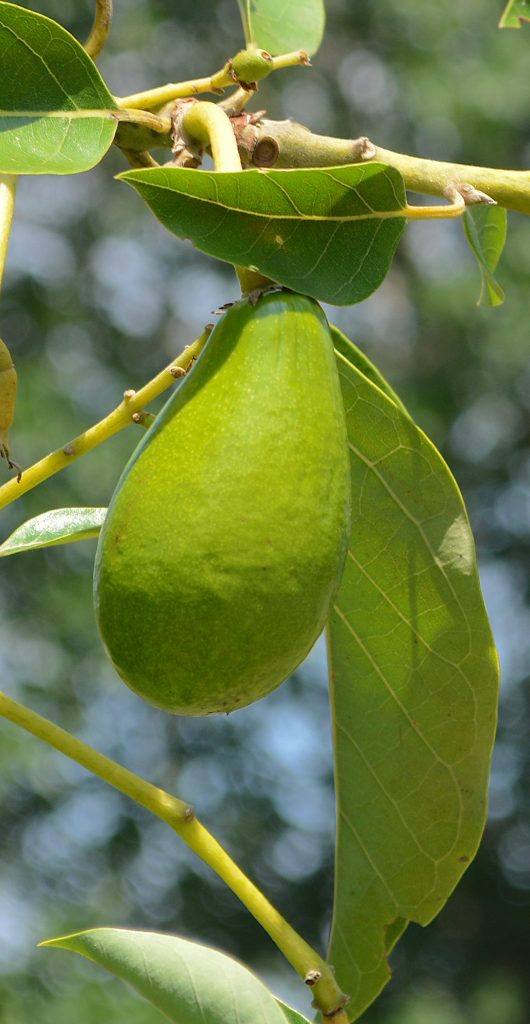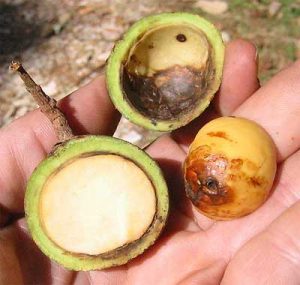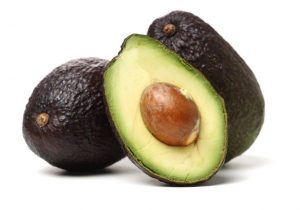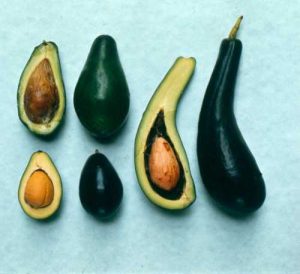
When avocados ripen is semi-predictable. Photo by Green Deane
Wild Avocados
Yes, there are wild, weedy avocados. They have a huge seed and thin pulp. The Aztec did not eat the seed nor should you.
Actually there are several varieties of avocados and given a chance they will sprout from seeds. The majority of avocados I eat are from trees here and there not under cultivation. While there are some four dozen or more species of avocado perhaps the truest wild form today is Persea schiedeana.

Wild avocados have huge seeds. Wild chimpanzees don’t eat them.
Called “aguacate de mono” or Monkey Avocado (and many other names) they range from ping-pong to baseball size, 100 grams to 450 grams. The seed is huge, the pulp is small. Like all avocados it does not ripen on the tree however it ripens quickly and can go bad within five days. In southern Mexico, Guatemala, El Salvador, Honduras, and Belize, the pulp is popular food and spread on tortillas and used in bean soup.
That said the Hass avocado — the small, wrinkly black one — is about 6.5 times the production of all the other varieties/species all together. But I don’t find naturalized Haas avocados so we’ll us the nutrition from a small green fruit like a Fuerte which is what I forage.

Hass avocados outsell all other kinds put together.
Per 100 gram serving there is 120 calories, 2.34 grams of protein, 10 grams of fat, 5.6 grams of fiber 2.17 grams of glucose and a very tiny amount of fructose. The minerals are potassium 351 mg, phosphorus 40 mg, magnesium 24 mg, calcium 10 mg, sodium 2 mg, zinc 0.4 mg, iron 0.17 mg, copper 0.311 mg, and manganese 0.095 mg. Vitamin C is 17.4 mg. The amount of B vitamins are small: B1 (thiamin) 0.021 mg, B2 (riboflavin) 0.053, B3 (niacin) 0.672 mg, B6 (pyridoxine) 0.078, pantothenic 0.931 mg, and folate 35 mcg. Beta carotene is 53 mcg, which is 140 IUs of vitamin A. There is some vitamin E, 2.66 mg.

The avocado of the Aztecs, P. drymifolia, is quite different.
The Aztecs used anise-smelling avocado leaves for flavoring. They wrapped food in the leaves of P. americana drymifolia (PER-see-uh uh-mair-ah-KAY-nuh drim-if-OH-lee-ah.) As for drying and eating the pits… the Aztecs, no matter how hungry, did not eat the pits. My speculation is it interferes with the gut biome and made them ill but they didn’t know why. Persea is the name giving to some unknown ancient tree in Greece that was thought to have come from Persia. Americana the american, Drymifolia is forest leaf or sharp/stinging/biting leaf. Schiedeana (she-dee-ANN-ah) commemorates German botanist Christian Julius Wilhelm Schiede (1780-1836) who collected plants in Mexico from 1828 to his death in 1836. A Tillandsia is also named for him.
Green Deane’s Itemized Plant Profile
IDENTIFICATION: There’s huge variety with three “races” and 50 varieties. They are an evergreen tree with glossy leaves that can be 10 to 60 feet depending on which one, it can be low and symmetrical to tall and asymmetrical. The fruit can be black, green, and purple, round, oval, and pear-shaped.
TIME OF YEAR: Depends on species and location. Different species in different climates can provide almost year-round production of fruit.
ENVIRONMENT: This also varies with the variety. Some are more salt tolerant than others, some more cool tolerant. Sun, rich well-drained soil and water makes them all grow well.
METHOD OF PREPARATION: A wide variety of ways from raw to used in cooked dishes. Wild

